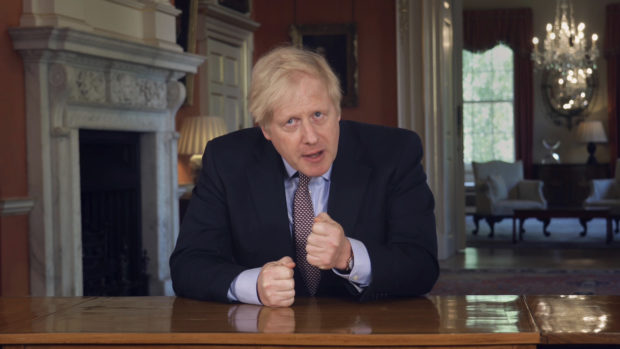LONDON — U.K. Prime Minister Boris Johnson on Sunday outlined a “conditional plan” for reopening British society in the coming months, including the possible return to school for some young children at the start of June, as well as some easing of the coronavirus lockdown in England.

In this grab taken from video issued by Downing Street on Sunday, May 10, 2020, Britain’s Prime Minister Boris Johnson delivers an address on lifting the country’s lockdown amid the coronavirus pandemic. (Downing Street via AP)
In a televised address to the nation, Johnson said this is “not the time, simply, to end the lockdown this week,” but that it was appropriate to make some changes, including encouraging people with jobs that cannot be done from home to return to work.
However, his plan of action lacked many details and raised a series of new questions, not least over potentially divergent approaches by the four constituent nations of the U.K. — England, Scotland, Wales and Northern Ireland. More details will be unveiled in Parliament on Monday.
Johnson said it would be “madness” to loosen restrictions so much that a second spike in cases emerges. The U.K. recorded as of Sunday almost 32,000 virus-related deaths, the most in Europe and the second-highest pandemic toll worldwide. Johnson said that without the lockdown, in place since March 23, half a million people may have lost their lives.
“We must continue to control the virus and save lives,” the prime minister said from an office at 10 Downing Street. “And yet we must also recognize that this campaign against the virus has come at colossal cost to our way of life.”
The lockdown has reduced the transmission of the novel coronavirus in the community, but has come at a heavy economic cost. Johnson, who returned to work only two weeks ago following his hospitalization for COVID-19, has come under pressure to relieve the pressure on the economy.
He said the government would proceed cautiously but that he could announce “the first careful steps” in relaxing the lockdown in England.
He said people who cannot work from home, such as those in construction or manufacturing, “should be actively encouraged to go to work” starting this week. However, he said they should not commute by public transportation and adhere to social distancing guidelines.
It was unclear how those with children can return if schools remain closed and how workplaces can be designated as safe.
And starting Wednesday, the government will also allow people to take “unlimited amounts” of exercise outdoors instead of being limited to once a day, Johnson said. Members of the public will be able to sunbathe, drive to destinations such as beaches, and play sports such as golf and tennis — but only with members of the same household.
The changes permit individuals to sit with a friend in a park provided they keep 2 meters apart, something prohibited during the lockdown. In theory, that means people can meet their mother or father, but not both. No details were provided on when people can meet with friends and family again.
Johnson said fines for violations of the social distancing rules would be increased.
The governments in Scotland, Wales and Northern Ireland, extended their lockdowns prior to Johnson’s speech and eased restrictions less than the steps the prime minister announced for England. That prompted questions over the potential for divergent approaches across the U.K. in the months ahead. Up until now, they have moved in lockstep on virus regulations.
Johnson is at odds with the leaders of Scotland, Wales and Northern Ireland after his government replaced its “Stay at Home” public health slogan with a new “Stay Alert” message, wording that raised concerns about the potential danger of mixed messaging. They said they would retain the “Stay at Home” message.
Scottish First Minister Nicola Sturgeon said she didn’t know what the new advice meant and has asked the U.K. government not to promote a “vague and imprecise” message in Scotland.
Keir Starmer, leader of the main opposition Labour Party, said he was worried about the four nations “pulling in different directions” and that Johnson failed to provide the necessary “clarity and consensus.”
Health experts also expressed concern about the new slogan.
Professor Til Wykes of the Institute of Psychiatry, Psychology and Neuroscience at King’s College London, said it “will just be confusing, be open to misinterpretation and likely to increase risky behavior.”
Johnson also laid out what he called “the first sketch of a road map for reopening society” in coming months, including the potential opening of shops and the return to school for some younger children as early as June 1.
He also expressed hope that segments of the hospitality industry and more public places could reopen a month later.
“Throughout this period of the next two months, we will be driven not by mere hope or economic necessity,” he said. “We are going to be driven by the science, the data and public health, and I must stress again that all of this is conditional, it all depends on a series of big ifs.”
He said the U.K. government was introducing a scale for measuring the threat from the virus. Johnson explained the COVID Alert Level will guide policy — the lower the level, the fewer the measures.
“We will be monitoring our progress locally, regionally, and nationally, and if there are outbreaks, if there are problems, we will not hesitate to put on the brakes,” he said.
Johnson also said it will “soon be the time” to require those arriving in the country by plane to quarantine. No further details were provided but there’s speculation that the quarantine would be 14 days unless travelers are coming from Ireland.
Anyone arriving from France will be exempt, Johnson’s office confirmed after a conversation between the prime minister and French President Emmanuel Macron.